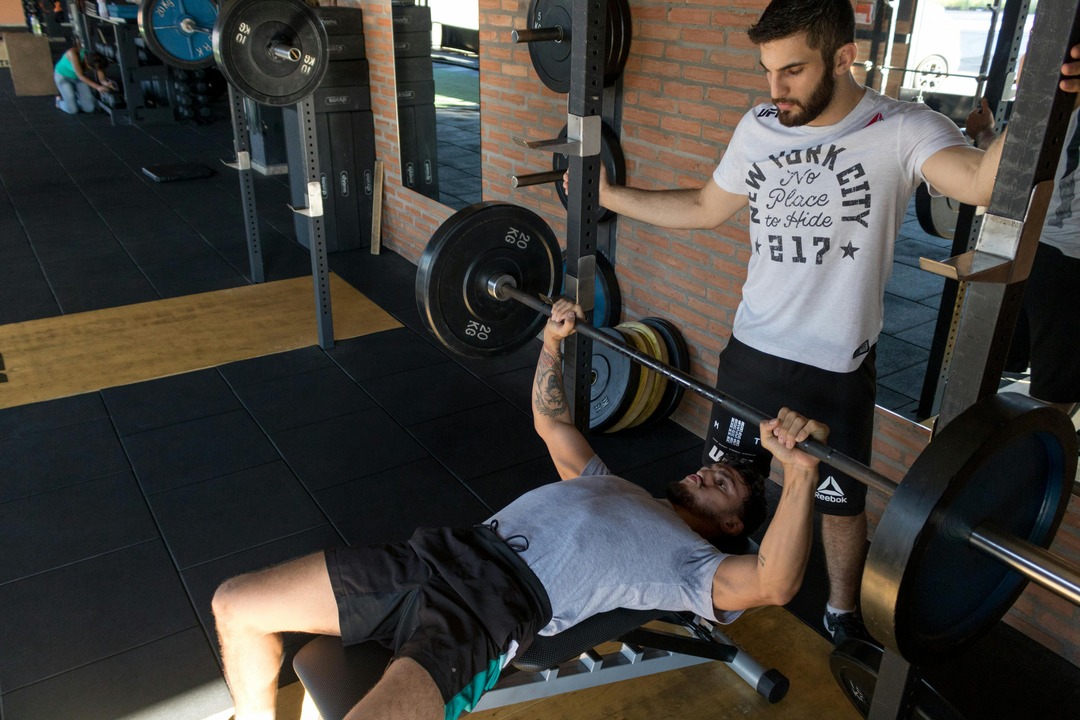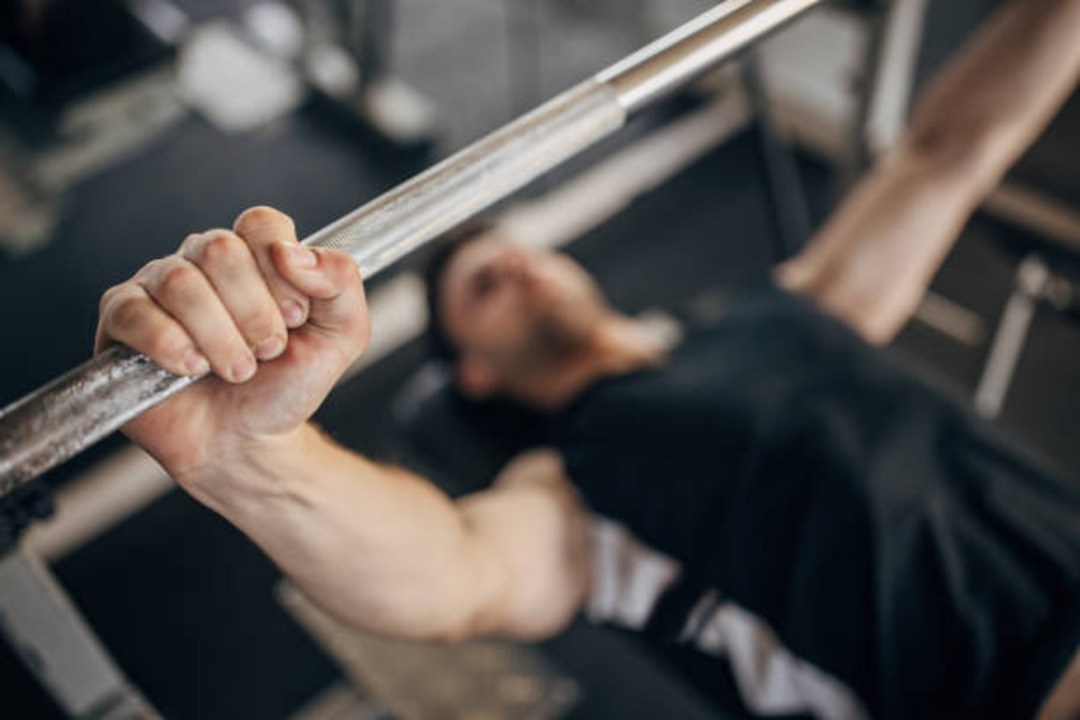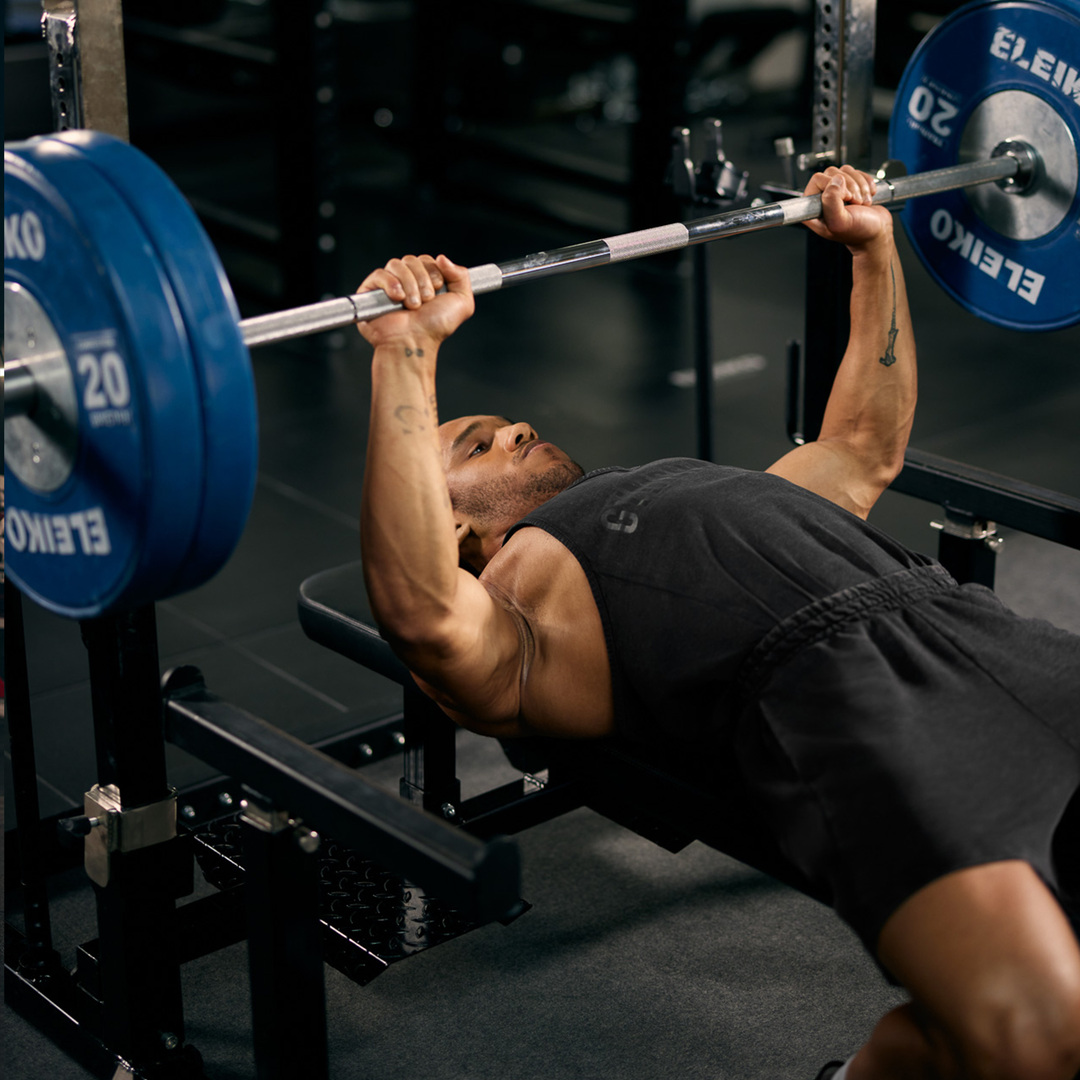How Much Can The Average Man Bench Press?

Find out how much the average man bench press by age and fitness level, and see how your strength stacks up.
How much can the average man bench press, and how do you tell if you are a novice, intermediate, advanced, or elite? Tracking bench press standards like one-rep max, bodyweight ratios, training age, and strength norms in the Best Fitness Apps gives you precise numbers instead of guesswork.
This article lays out ranges for each level, explains typical reps and percentage targets, and shows how those fitness benchmarks can guide your training.
GetFit AI's solution, an AI fitness app, turns those benchmarks into a simple plan that uses your current lifts and body weight to place you in the correct category and map out safe, step-by-step progress.
Summary
- The typical untrained male one-rep max sits around 135 pounds. In comparison, an intermediate lifter averages about 215 pounds, indicating that training age and bodyweight ratios shift expected strength benchmarks more quickly than linearly. This is where GetFit AI fits in; it uses your current lifts and bodyweight to place you in the correct category and map out step-by-step progress.
- Early training yields fast 1RM gains when technique, frequency, and accessory work align, with practical frequency targets of two to three bench sessions per week and conservative load jumps of 2.5 to 5 pounds to avoid plateaus. GetFit AI addresses this by auto-adjusting loads and progression logic based on recent session data and recovery signals.
- Generic, one-size-fits-all programs commonly produce predictable plateaus and unnecessary fatigue, which helps explain why only about 1 percent of gym-goers reach a 225-pound bench without long-term, focused training. This is where GetFit AI fits in, it personalizes progression so incremental gains compound rather than stall.
- Heavy milestones are rare, with roughly 1 percent of gym regulars able to bench 225 pounds and approximately the same thin slice reaching 300 pounds, a level typically achieved after three to seven years of targeted practice. GetFit AI addresses this by tracking objective trends, like bar speed and repeat top sets, so users can judge whether chasing those numbers aligns with their recovery and priorities.
- Targeted interventions move strength faster than more volume alone; for example, velocity work in the 30-60% range. Cluster sets preserve intent, and one study showed participants increased their bench by an average of 20 pounds over four weeks using focused protocols. This is where GetFit AI fits in: it centralizes session metrics, such as bar velocity and RPE, to recommend when to increase load and when to add volume.
- Progress is most reliable when measured with repeatable tests and recovery markers, and user feedback indicates that structured, adaptive programs matter: GetFit AI has reported over 1 million downloads, and 90 percent of surveyed users noted improved fitness after three months. GetFit AI addresses this by combining athlete-inspired routines with auto-adjusting progressions and recovery-aware decision rules.
How Much Can The Average Man Bench Press?

The average untrained man’s one-rep max is near the average male bench press of 135 pounds. That number, from Strength Level, is a practical baseline for categorizing typical, mostly non-resistance-trained men. For contrast, a more practiced lifter is grouped higher on the same chart. An intermediate male lifter can bench press 215 pounds. Uses those ranges to show how experience shifts expected one-rep maxes.
How does training experience and bodyweight change that baseline?
Training moves the needle a lot, and not linearly. A man who starts at the average baseline can raise his 1RM rapidly at first by improving technique, increasing training frequency to two to three bench sessions per week, and adding targeted accessory work. Body mass and limb lengths shift leverage and absolute numbers, too, so two men who both bench 135 may have very different strength potential based on weight and structure. Think of the baseline as a speedometer reading when you first buy a car, useful for orientation but not destiny.
What common mistakes stall progress?
Most lifters follow generic programs because they are familiar and straightforward. That comforts them, but the hidden cost is predictable plateaus and unnecessary fatigue, as loads either jump too fast or never change at all. When programming lacks progression specific to an individual’s recovery, technique flaws compound, and slight imbalances become hard limits. Platforms like GetFit AI provide individualized progression logic and auto-adjusting loads based on performance data, giving athletes consistent, evidence-based increments and technique cues while preserving recovery, so improvements compound rather than stall.
How should you set realistic targets from the average?
Set sliding benchmarks rather than a single magic number. Start with technique and consistent frequency for 8 to 12 weeks, then use small, measurable increases, such as adding 2.5 to 5 pounds to the bar or adding a planned rep at the same weight before increasing load. Monitor fatigue, not ego; scale accessory work for triceps, shoulders, and upper back to support pressing strength. I coach weekend lifters over 12-week blocks, focusing first on bar speed and tight setup, and then on sustainable loading increments, because steady, trackable progress beats dramatic, short-lived jumps.
A short image to hold: the bench press is a barometer, not a verdict; it tells you where your current system is, and where sensible training can take it.
That baseline leaves a charged question about respect, context, and what real progress looks like in the gym.
Related Reading
- Best Fitness Apps
- How Many Pull Ups Should I Be Able To Do
- Average Bench Press By Age
- Average Grip Strength Male
- Average Bench Press
- How Much Does A Bench Press Bar Weigh
- Average Male Bench Press
- Grip Strength Chart
Is 135 a Respectable Bench?

Yes. A 135-pound bench is often a respectable early, measurable milestone, but its real value lies in what it predicts about progress, not how it looks on social media. Instead of treating 135 as a verdict, treat it as a diagnostic point that tells you which training choices will move you forward fastest.
How should I compare 135 to my bodyweight and goals?
Compare the lift to your bodyweight and training history, not to some abstract idea of what’s “impressive.” A bench that equals your bodyweight means something different if you weigh 180 pounds than if you weigh 140. More useful than absolute numbers is the ratio between your bench and your body mass, and the trend over weeks of consistent work. According to Healthline, the average untrained man can bench press approximately 135 pounds, which is a baseline for people doing minimal resistance training and not a fixed destination; move the ratio upward, and the lift’s meaning changes with you. For context, Healthline (2019) also reports that a novice male lifter can bench press 175 pounds, which helps set an early progression target once technique and frequency improve.
What actually makes 135 feel easy or impossible for different people?
This is a pattern we see across clients and gym-goers: limb length, shoulder health, bar path, and nervous system readiness often explain far more of the gap than “effort” alone. If your setup is tight, your scapulae retracted, and your bar path is straight, 135 will feel steadier and more repeatable. If any of those elements are missing, the same 135 becomes grindy and inconsistent. That explains why two people with identical bodyweight and the same 1RM can have very different training ceilings; one fixes a minor setup issue and hits immediate, measurable gains.
Why does progress stall after hitting 135 for some lifters?
Most stall points come from a mismatch between program stress and recovery behavior. When training frequency, accessory choices, or load increments ignore an individual’s recovery, gains slow. The failure mode is predictable: volume creeps up or technique is neglected, fatigue accumulates, and the bar speed goes down while perceived effort rises. This is not moral failure; it is programming friction. That friction is why many lifters feel embarrassed at 135, even though the real bottleneck is how their plan is structured around their life and recovery.
Most lifters progress using generic templates because they are familiar and straightforward. That works at first, but as you add work and life stress, those templates fragment: load jumps are either too aggressive or too timid, accessory work misses weak links, and minor technique faults compound into persistent plateaus. Platforms like GetFit AI provide individualized progression logic and auto-adjusting loads that reflect your recent session data, giving a clear, safe path from an early 1RM to stronger, sustainable numbers without overloading recovery or ignoring form.
What small changes reliably move 135 into a higher training band?
Focus on three surgical changes rather than broad, dramatic overhauls. First, tighten your setup and practice explosive concentric intent at submaximal loads to improve bar speed. Second, add targeted accessory work for triceps and upper back with controlled volume for eight to twelve weeks, monitoring bar speed and repetition quality.
Third, test progress with conservative, repeatable protocols, such as two sets of doubles at a planned top-set intensity every two weeks to detect real strength gains without fatiguing the system. Think of the process like tuning a guitar, not replacing the instrument; minor adjustments yield a clearer tone.
A short, concrete image: if 135 is a first passport stamp, then steady tempo, measured volume, and smarter load decisions are the travel itinerary that gets you to the following country.
That simple milestone carries more friction and hidden hope than most people admit, and the real test comes when you try to scale it without breaking your routine.
Can the Average Man Bench Press 225?

No, the average man does not typically bench press 225 pounds; that weight sits well above what most gym-goers reach without focused, multi-year training. In plain terms, 225 is both uncommon and treated as a milestone for more advanced lifters, not a baseline achievement.
What actually blocks most people from hitting 225?
This pattern appears across commercial gyms and weekend lifters: progress slows when programming, nutrition, and recovery are mismatched. Insufficient calories and protein blunt muscle repair, recurring technique faults create chronic shoulder or tendon pain, and random training frequency chews through momentum without delivering progressive overload. The emotional side is real, too; many lifters feel stuck for years, and that frustration compounds into half-hearted sessions that do not build the nervous system strength needed for heavy singles.
How should you change training when the bar stops moving?
Shift from generic volume to targeted quality. Prioritize two to three focused pressing sessions per week with clearly planned intensity blocks, add targeted accessory work for triceps, pecs, and upper back, and track bar speed and set quality rather than chasing reps. Think of it like tuning an engine: minor, measurable adjustments to timing and fueling produce more reliable power than random, longer mechanic sessions.
What nutritional targets actually matter?
For strength gains, a modest calorie surplus and consistent protein intake matter more than occasional protein shakes. Aim for a steady, controllable surplus that supports recovery without excessive fat gain, and divide protein across meals to support repeated muscle repair signals. When those basics are absent, training adaptations stall even if technique improves.
What does the training status quo cost you?
Most lifters manage progress with one-size-fits-all plans because they are familiar and straightforward. That works early, but as loads increase, the familiar approach fragments: progress becomes inconsistent, fatigue accumulates, and minor technique flaws turn into persistent plateaus. Platforms like GetFit AI provide individualized progression logic and auto-adjusting loads based on session data, giving athletes consistent, evidence-based increments and technique cues while preserving recovery, which compresses wasted months of trial and error into dependable, steady gains.
When is chasing 225 the right decision?
Ask three questions before you commit: do you have the recovery margin to tolerate higher intensity, do you have shoulder and scapular stability to press safely, and does the goal align with your priorities beyond vanity? If you lack recovery capacity, prioritize mobility and volume control; if technique is the limiter, slow down and focus on the bar path and tightness. This trade-off thinking prevents the standard failure mode in which eagerness for big numbers leads to avoidable injury and stalled progress.
How rare is 225, really?
Labels matter here. Only about 1% of gym-goers can bench press 225 pounds. That 2014 Reddit comment captures the practical rarity you see walking through most commercial gyms, a reminder that hitting 225 places you among a small subset of committed lifters. And for clarity on how strength communities classify it, A 225-pound bench press is considered advanced for a man. That 2014 phrasing reflects the way experienced lifters set benchmarks, not a moral judgment.
What should you measure to know you are getting closer?
Replace chasing a headline number with a simple testing protocol you can repeat every 6 to 12 weeks: a planned top set at a controlled intensity, two supporting heavy doubles, and clear bar speed thresholds. Track recovery markers, sleep quantity, and weekly protein consistency alongside lifts. When those data points trend together, heavy singles become predictable instead of accidental.
If you are tired of spinning wheels, what feels different when it starts working?
You stop being surprised by progress. Sessions have rhythm, setbacks are temporary, and confidence replaces anxious attempts at one-rep glory. That shift from random hustle to consistent engineering is what separates someone who hits 225 once from someone who earns it repeatedly.
That raises a sharper question about elite rarity, and the answer in the next section will change how you measure strength.
Related Reading
- Bench Press Standards
- Do Pull Ups Work the Chest
- Symmetric Strength
- Grip Strength Norms
- Average Deadlift Weight
- 1 Rep Max Chart
- Average Male Deadlift
- Good Bench Press Weight
- Weightlifting Standards
How Rare is a 300lb Bench Press?

A 300-pound bench press is rare enough to be a clear marker of elite-level pressing for the typical gym-goer, not a milestone most casual trainees reach. Only a thin slice of lifters ever get there; when it happens, it usually reflects years of targeted practice, favorable leverage, and disciplined recovery.
How rare is 300 in everyday gyms?
Only about 1% of gym-goers can bench press 300 lbs. All About Powerlifting, 2019, you will probably go months in a commercial gym without seeing the number on the bar. That 1 percent lives mostly in dedicated strength communities, small strength-focused facilities, and competitive powerlifting meets, not on a crowded cardio floor.
Who typically reaches 300, and what do they have in common?
A 300 lb bench press is considered elite for the average gym-goer. All About Powerlifting, 2019, which signals this is not a casual weekend-warrior achievement but a result of specific training choices. The typical pattern is consistent progressive overload across multiple years, planned peaking phases, and deliberate accessory work for triceps and upper back. Most lifters who hit this have spent roughly three to seven years training with increasing specificity, and they monitor recovery metrics like sleep and weekly training stress.
What factors make 300 unusually hard to reach?
Technique and nervous system strength matter as much as muscle mass. Bodyweight and limb length change leverage drastically; a heavier lifter with shorter arms usually gets there sooner than a lighter lifter with long arms, all else equal. Tendon and shoulder health constrain heavy loading for many, so the scarcity of 300 is partly medical, not just motivational. The failure mode I see repeatedly is not poor effort; it is mismatched progression, where volume, intensity, and life stress collide, slowing adaptation for months.
Most people follow familiar programs that look right but break under load.
Most lifters stick with generic, one-size-fits-all templates because they are easy and familiar. That approach works early, but as intensity rises, it fragments: minor technique flaws become chronic, recovery gaps widen, and progress stalls or injury risk climbs. Platforms like GetFit AI provide individualized progression logic and auto-adjusting loads, guided by recovery-aware decision rules, helping lifters compress trial-and-error into steady, safe gains while preserving joint health.
What should you measure instead of chasing the headline number?
Track objective trends, not single one-rep attempts. Weekly bar speed, repeat top sets at submaximal intensities, and recovery markers tell you whether your system is adapting or just surviving. Think in blocks of months, not single gym sessions; the people who convert heavy targets into reliable performance test systematically and adjust based on real data.
Reaching 300 feels less like a sudden jump and more like tuning a high-performance engine; minor, precise adjustments at each service interval decide whether the machine coughs or roars.
But the real test is coming next, and it changes everything about how you should train.
How to Improve Your Bench Press

Train the nervous system and shore up specific weak links, not just pile on sets. Use targeted speed work, heavy partials, and data-driven autoregulation so each session teaches your body to express more force, cleaner, and more often.
How should you train bar speed and rate of force production?
Use short, explosive sets in the 30 to 60 percent range for velocity work, then follow with a few heavy singles or doubles for specificity. Cluster sets, where you break a heavy set into 2 to 4 mini-sets with brief rests, keep intent high and fatigue low, which preserves technique while increasing neural drive. Think of bar speed as engine revs: you want more revs at a given gear before asking for a higher gear. Monitor intent with simple tools, like a phone video or a cheap linear encoder, and treat declines in velocity as a trigger to stop or back off.
Which accessory actually moves the needle?
Prioritize movements that fix the exact sticking point in your press, not the ones that just feel hard. For a slow lockout, add board presses or rack lockouts twice weekly for 4 to 8 weeks, keeping reps low and load high; for a soft midrange, use paused bench work and heavy isometrics at that range. Upper-back rowing and face pulls are not optional; they restore the force-transmission platform for every heavy rep. Sequence accessories so the neurological work comes first, then controlled hypertrophy work for volume.
When should you increase load versus volume?
When your top sets are fast and technique is solid, increase load; when bar speed drops and form frays, add volume, not weight. Use short, focused intensity blocks and planned testing microcycles to convert volume into strength without burning out. In fact, short, concentrated interventions can produce rapid gains, as one report showed [Participants in the study increased their bench press by an average of 20 pounds over four weeks — Journal of Exercise Physiology Online. That result illustrates how swapping unfocused chasing of reps for tight, high-intent cycles pays off.
How do you use objective feedback to steer progression?
Move beyond reps and sets to two numbers: bar velocity and perceived exertion. An RPE 8 rep that stays fast for three weeks means you can add weight; an RPE 8 that slows signals a recovery or technical issue. Track sleep, resting heart rate, and a simple readiness score; when those trend down, favor technique and speed instead of pushing intensity. Set goals relative to your mass, because relative targets are both fair and motivating, and remember that the average male lifter can bench press 1.5 times their body weight — REP Fitness Blog, gives you a scalable benchmark to measure progress against leverage and body composition.
Most lifters default to a fixed weekly template because it is familiar and easy to follow. As loads increase, though, that template fragments: progress becomes inconsistent, technique slips, and months of work feel random rather than cumulative. Platforms like AI fitness app centralize session data, auto-adjust loads based on recent bar speed and RPE, and introduce recovery-aware rules, which compresses months of guesswork into consistent, safer gains.
How should you sequence recovery and deloading so that strength actually sticks?
Plan reactive deloads instead of calendar deloads, using objective drop-offs in velocity or persistent RPE inflation as your signal to reduce intensity. Include a low-intensity week every 4 to 8 weeks, depending on the workload, and use targeted mobility and soft-tissue tools on high-stress joints after heavy sessions. Think in blocks of competence, not punishment; the strongest lifts come from systems that can recover and repeat the exact high-quality reps that caused adaptation.
Ready to train like the legends and finally achieve the body you've always wanted? GetFit AI's AI fitness trainer app lets you follow the exact workout routines that made Arnold Schwarzenegger, Kobe Bryant, Cristiano Ronaldo, Serena Williams, and 11+ other elite athletes into champions. You can also chat with them whenever you need guidance or motivation. Download the #1-rated AI fitness app for free today to get fit for less than the cost of a single month's gym membership, because greatness isn't born —it's built one workout at a time.
That feels decisive, but the next move will change everything about whose workouts you follow and how closely they match your body.
Make Your Favorite Athlete Your Fitness Trainer | Try GetFit AI's AI Trainer App for Free Today 💪

If you want athlete-level programming that adapts to your body and life, consider GetFit AI When we reviewed user feedback during recent updates, the pattern became clear: people were frustrated by rigid exercise lists and wanted deeper customization and steady, incremental improvements so progress felt reliable rather than random. Over 1 million downloads and 90% of users reported improved fitness levels after 3 months. GetFit AI User Survey, so trying it gives you athlete-inspired plans, easy exercise edits, and auto-adjusting progressions that turn consistency into measurable gains.
Related Reading
- Average Bench Press By Age 16
- Best Free Workout Apps
- Best Calisthenics Workout App
- Average Deadlift Weight For Male
- Average Deadlift Weight Kg
- Best Workout Apps
- Best Hiit Workout App
- Best Workout Tracker App
- Average Bench Press Kg By Age
- Best Gym Workout App
- How Many Pull-Ups Can the Average Person Do
- Pull-Up Strength Standards
- Weighted Pull-Up Standards
- Weighted Dips Strength Standards
- Grip Strength Standards
- Average Dumbbell Shoulder Press
- Average Incline Dumbbell Press



.png)
.png)











